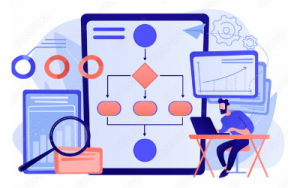Earlier this month, we launched a proprietary brand-audience perception analysis engine called Dentsu BrandSense & Dentsu AudienceSense (Read More: https://brandinginasia.com/dan-data-sciences-launches-audience-perception-analysis-engine-dentsu-brandsense/)
What is the Dentsu BrandSense & Dentsu AudienceSense in a nutshell?
With a view to better decode the way brand and audiences interact, Dentsu Marketing Cloud brings to you a proprietary brand-audience analysis engine that will be housed under the marquee audience insights engine of the Dentsu Aegis Network – DAN Explore. It will have 2 key components – first, analyzing a brand’s communication on social media and marketing channels (Dentsu BrandSense), and second, analyzing how audiences respond to those brand communication channels (Dentsu AudienceSense).
Why is understanding Audience & Brand perception important?
The goal of every marketing endeavor is to create memorable experiences for brands and audiences to interact and inspire a form of action or maintain recall. In an era where audiences are inundated with brand-led messaging and where consumers have defaulted to “glance and scan”, it is important for brands to create content that resonates with their audiences, making the understanding of the brand and audience perceptions crucial now more than ever.
What does Dentsu BrandSense & Dentsu AudienceSense do for this?
The endeavor of Dentsu BrandSense and Dentsu AudienceSense is to bridge the gap between how a brand’s tone is being perceived by a brand’s audiences, and how a brand’s audience reacts to a brand.
We understood that consumers are often attracted to certain brands because they reinforce the idea they have of themselves – for example, sophisticated, intelligent, witty or attractive – and allow them to make a statement. Data illustrating how consumers perceive themselves in relation to a brand is hugely valuable, allowing companies to capitalize on deep-rooted motivating factors.
One of the greatest use cases of these tools is in the realm of influencing creative and communication strategies. For example – if you are a large bank, you don’t want your communication to rub off as being “Risk-Taking”.
How does Dentsu BrandSense & Dentsu AudienceSense work?
Currently supporting Twitter & Facebook as ecosystems, the tool scans through brand posts and audience engagement on these platforms. It then ingests this corpus into a proprietary perception analyzer built using industry-leading personality algorithms such as the likes of IBM Watson, Google NLU and Azure Text Analytics APIs.
Dentsu BrandSense and Dentsu AudienceSense can then infer, from potentially noisy social media, portraits of individuals that reflect their personality characteristics and also display the consumption preferences of the audience.
Personalities derived by Dentsu BrandSense and Dentsu AudienceSense are based on the psychology of language in combination with data analytics algorithms. We largely use the Big 5 personality types as our base.
Getting started with Dentsu BrandSense & Dentsu AudienceSense
The Input
Step 1: Select the Lens “Explore Asset inside DAN Explore”

Note: While it mentions 24 DDL Coins, Dentsu BrandSense and Dentsu AudienceSense take only 2 DDL Coins to run. In case you are out of DDL Coins, you can purchase a new package from our View/Purchase option:

Step 3: Input ONLY the Facebook Page & Twitter Handle section if you want to run Dentsu BrandSense & Dentsu Audience Sense

Note: You do not need to have any access to the Facebook Page or Twitter handle to be able to run this tool and get insights
Step 4: Hit “Explore” to initiate your run and fetch insights

Decoding the Output
The output of Dentsu BrandSense and Dentsu AudienceSense is displayed in the form of a spider chart to represent where the brand’s personality is leaning towards and which personality type the brand’s audience is leaning towards.

The result of Dentsu BrandSense is denoted by:

The result of Dentsu AudienceSense is denoted by:

Personality Insights from Dentsu BrandSense and Dentsu
AudienceSense is derived using the Big Five personality characteristics.
Big Five personality characteristics represent
the most widely used model for generally describing how a person engages with
the world. The model includes five primary dimensions:
Agreeableness is a person’s tendency to be
compassionate and cooperative toward others.
Conscientiousness is a person’s
tendency to act in an organized or thoughtful way.
Extraversion is a person’s tendency to seek
stimulation in the company of others.
Emotional range, also referred to as Neuroticism or Natural reactions, is the extent to which a person’s emotions are sensitive to a person’s environment.
Openness is the extent to which a person is open to
experiencing different activities.

Each of these top-level dimensions has six facets that
further characterize an individual according to the dimension.
These can be further analysed by clicking on each of the labels as under:

Agreeableness is a person’s tendency to be compassionate and
cooperative toward others. The tables that follow qualify results for
characteristics as high or low:
Any score above the mean of 0.5 indicates a greater than
average tendency for a characteristic. A score at or above 0.75 indicates
readily discernible aspects of the characteristic; such scores are considered
high.
The opposite statements are true of scores below 0.50 and 0.25, which are considered low.

Facet Individuals who score high…
Altruism / Altruistic Find that helping others is genuinely
rewarding, that doing things for others is a form of self-fulfillment rather
than self-sacrifice.
Cooperation / Accommodating / Compliance Dislike confrontation. They are
perfectly willing to compromise or to deny their own needs to get along with
others.
Modesty / Modest Are
unassuming, rather self-effacing, and humble. However, they do not necessarily
lack self-confidence or self-esteem.
Morality / Uncompromising / Sincerity See no need for pretense or
manipulation when dealing with others and are therefore candid, frank, and
genuine.
Sympathy / Empathetic Are tender-hearted and compassionate.
Trust / Trusting of others Assume that most people are fundamentally fair, honest, and have good intentions. They take people at face value and are willing to forgive and forget.

Conscientiousness is a person’s tendency to act in an
organized or thoughtful way. The tables that follow qualify results for characteristics
as high or low:
Any score above the mean of 0.5 indicates a greater than
average tendency for a characteristic. A score at or above 0.75 indicates
readily discernible aspects of the characteristic; such scores are considered
high.
The opposite statements are true of scores below 0.50 and 0.25, which are considered low.

Facet Individuals
who score high…
Achievement striving / Driven Try hard to achieve excellence. Their
drive to be recognized as successful keeps them on track as they work hard to
accomplish their goals.
Cautiousness / Deliberate / Deliberateness Are disposed to think through possibilities
carefully before acting.
Dutifulness / Dutiful / Sense of responsibility Have a strong sense of duty and
obligation.
Orderliness / Organized Are well-organized, tidy, and neat.
Self-discipline / Persistent Have the self-discipline, or
“will-power,” to persist at difficult or unpleasant tasks until they
are completed.
Self-efficacy / Self-assured / Sense of competence Are confident in their ability to accomplish things.

Emotional range, also referred to as Neuroticism or Natural
reactions, is the extent to which a person’s emotions are sensitive to the
individual’s environment. The tables that follow qualify results for characteristics
as high or low:
Any score above the mean of 0.5 indicates a greater than
average tendency for a characteristic. A score at or above 0.75 indicates
readily discernible aspects of the characteristic; such scores are considered
high.
The opposite statements are true of scores below 0.50 and 0.25, which are considered low.

Facet Individuals
who score high…
Anger / Fiery Have
a tendency to feel angry.
Anxiety / Prone to worry Often feel like something unpleasant,
threatening, or dangerous is about to happen. The “fight-or-flight”
system of their brains is too easily and too often engaged.
Depression / Melancholy / Moodiness Tend to react more readily to life’s
ups and downs.
Immoderation / Self-indulgence Feel strong cravings and urges that they
have difficulty resisting, even though they know that they are likely to regret
them later. They tend to be oriented toward short-term pleasures and rewards
rather than long-term consequences.
Self-consciousness Are sensitive about what others think of
them. Their concerns about rejection and ridicule cause them to feel shy and
uncomfortable around others; they are easily embarrassed.
Vulnerability / Susceptible to stress / Sensitivity to stress Have difficulty coping with stress. They experience panic, confusion, and helplessness when under pressure or when facing emergency situations.

Extraversion is a person’s tendency to seek stimulation in
the company of others. The tables that follow qualify results for
characteristics as high or low:
Any score above the mean of 0.5 indicates a greater than
average tendency for a characteristic. A score at or above 0.75 indicates
readily discernible aspects of the characteristic; such scores are considered
high.
The opposite statements are true of scores below 0.50 and 0.25, which are considered low.

Facet Individuals
who score high…
Activity level / Energetic Lead fast-paced and busy lives. They do
things and move about quickly, energetically, and vigorously, and they are
involved in many activities.
Assertiveness / Assertive Like to take charge and direct the
activities of others. They tend to be leaders in groups.
Cheerfulness / Cheerful / Positive emotions Experience a range of
positive feelings, including happiness, enthusiasm, optimism, and joy.
Excitement-seeking Are easily
bored without high levels of stimulation.
Friendliness / Outgoing / Warmth Genuinely like other people and openly
demonstrate positive feelings toward others.
Gregariousness / Sociable Find the company of others pleasantly stimulating and rewarding. They enjoy the excitement of crowds.

Openness, or Open to Experience, is the extent to which a
person is open to experiencing a variety of activities. The tables that follow
qualify results for characteristics as high or low:
Any score above the mean of 0.5 indicates a greater than
average tendency for a characteristic. A score at or above 0.75 indicates
readily discernible aspects of the characteristic; such scores are considered
high.
The opposite statements are true of scores below 0.50 and 0.25, which are considered low.

Facet Individuals
who score high…
Adventurousness / Willingness to experiment Are eager to try new activities and
experience different things. They find familiarity and routine boring.
Artistic interests Love beauty, both in art and in nature.
They become easily involved and absorbed in artistic and natural events. With
intellect, this facet is one of the two most important, central aspects of this
characteristic.
Emotionality / Emotionally aware / Depth of emotions Have good access to and awareness of
their own feelings.
Imagination Views the real world as often too plain and ordinary. They use fantasy not as an escape but as a way of creating for themselves a richer and more interesting inner-world.
Intellect / Intellectual curiosity Are intellectually curious and tend to
think in symbols and abstractions. With artistic interests, this facet is one
of the two most important, central aspects of this characteristic.
Liberalism / Authority challenging / Tolerance for diversity Have a readiness to challenge
authority, convention, and traditional values.
Platforms Analysed
In the current version of Dentsu BrandSense and Dentsu AudienceSense, the two platforms analyzed are Facebook (platform) and Twitter.

Can I see what content is analysed?
For each platform analyzed, you can view the posts/tweets that the tool takes into consideration to generate the output for Dentsu BrandSense and Dentsu AudienceSense.
For Facebook
Step 1: Click the “View Analysed Posts” button at the bottom of the output screen

You will get a list of posts that the tool analyses. Posts are selected based on recency & engagement.

For Twitter
Step 1: Click the “View Analysed Posts” button at the bottom of the output screen

You will get a list of tweets that the tool analyses. Tweets are selected based on recency & engagement.

Decoding Consumption Preferences
For each platform (Facebook & Twitter), you will notice a tab:

This denotes “Consumption Preferences”. The relationship between personality and purchasing behavior was studied across various products and services:
Chen, Tsai. Personality Traits Hierarchy of Online Shoppers.
International Journal of Marketing Studies, Vol. 3(4) (November 2011): pp.
23-39.
Schlegelmilch, Bodo B., Greg M. Bohlen, and Adamantios
Diamantopoulos. The Link between Green Purchasing Decisions and Measures of
Environmental Consciousness. European Journal of Marketing, Vol. 30(5) (1996):
pp. 35-55.
And many others. Applying these known relations between
consumption behaviours and personality is challenging. Most of the works used
personality data derived from surveys, and their models are not publicly
available.
The Data Sciences Division of Dentsu Aegis Network (India),
therefore decided to embark on a journey to learn from models developed by
platforms such as IBM Watson, Google NLU and many others to calculate
consumption preferences dependent on personality type.
These are then condensed into 8 high-level categories to determine and position the likelihood to prefer different products, services, and activities.

Upon clicking “View More” for each preference, one gets a
score towards which the audience leans towards enabling content teams and
strategy teams to better identify their audiences.
For some preferences, the score is one of three values:
0.0: The brand/brand audience is very unlikely to prefer the
item. For some preferences, you can interpret the value as meaning that the brand/brand
audience has a low level of interest.
0.5: The brand/brand audience is neutral about the item. For
some preferences, the value can mean that the brand/brand audience has a medium
level of interest.
1.0: The brand/brand audience is very likely to prefer the
item. For some preferences, the value indicates a high level of interest.
For other preferences, the score represents a binary value. The author of the input text is either unlikely (0.0) or likely (1.0) to have an interest in the item, or the brand/brand audience has either a low or high level of interest.
In Conclusion
Dentsu BrandSense and Dentsu AudienceSense is a powerful tool
to help decode audiences and brand positioning better. This comes with multiple
use cases such as: developing a content strategy, tracking how a brand wishes
to be perceived by their audiences vis a vis how the brand is actually perceived,
helping brands identify whether their content is engaging the right audiences
and a lot more. We hope this guide will help you navigate this tool better.en

Dentsu Aegis Network


